Carl E. Olson's Blog, page 118
December 10, 2013
Subsidiarity
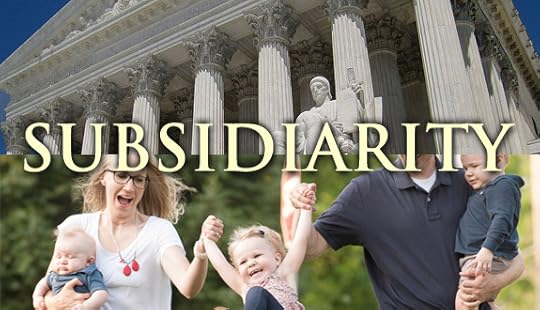
Subsidiarity | James Kalb | CWR
Why is this basic principle of Catholic social teaching praised more than it is practiced?
Subsidiarity is a basic principle of Catholic social teaching. Like other such principles, it is praised more than practiced, because it is at cross purposes with the outlook that now governs our public life.
It springs from concern for man in all his dimensions. Each of us participates in the human nature that is common to all. Each of us also has his own will and destiny, and knows who he is through a social identity that includes local and particular connections. So we are at once universal, individual, and socially situated, and become what we are through active participation in a complex of networks and institutions.
Concern with that aspect of human life puts Catholic social teaching at odds with the understandings of social life now dominant, which take equality and efficiency as their concern, and consequently want to reduce society to a sort of machine run from the top down for simple purposes. Such understandings make man less than he is, and end up treating him at bottom as an employee, voter, and consumer: someone who holds a position in a system of production and distribution designed and run by other people, periodically registers his assent to that system and how it is governed, and otherwise is free to amuse himself however he wants, as long as he doesn’t interfere with other people or the smooth operation of the system.
Dissent from that vision puts Catholic social teaching at cross purposes with every other political ideal now prominent. Catholic teaching wants man to be an effective participant in his world, so it wants the center of gravity of social life to be within his reach. For that reason it insists, in the face of the modern tendency toward the industrialization of social relations, on making the business of society as local as reasonably possible. It therefore asserts the principle of subsidiarity, which insists that lower-level groups such as families and local communities are not tools in the hands of higher-ups but have their own life and integrity that must be respected.
Subsidiarity rejects all forms of tyranny. It makes hierarchy more a matter of enabling those in the middle and bottom to carry on their lives than giving those at the top the power to plan out what is wanted and see to its achievement. It rejects the conception of social justice most common today, which emphasizes equality and universality and thus a comprehensive system of supervision and control. Instead, it stands for the Catholic and classical conception of social justice, a state of affairs in which each part of the social order receives its due so it can carry out its proper function.
More generally, it rejects present-day liberalism, the attempt to turn the social order into a technically rational contrivance for maximum equal satisfaction of individual preferences.
December 9, 2013
A Convert's Roman Pilgrimage
by Christopher White | CWR blog
On five days in Rome with 2,000 years of living history and 500 pages of learned guidance
Last week I enjoyed a wonderful five days in Rome. While I'd previously spent a fair amount of time in the city, this was my first return following my conversion to Catholicism in 2010.
I remember a visit in 2007 where I attended a general audience with Pope Benedict XVI and being profoundly moved, even as a Protestant, at the sheer power and draw of the papacy. Since that time, my understanding of the role of the successor to Saint Peter has been considerably enriched and it was with deep appreciation that I attended an audience with Pope Francis last
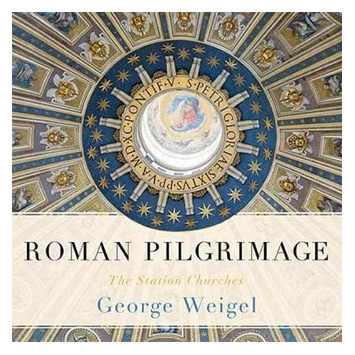 Wednesday. As the Holy Father made his way through St. Peter’s Square—and the nearly 50,000 in attendance snapped photographs, cheered, and passed their babies to be blessed by him—I couldn’t help but to reflect on the rich symbolism at play. There we were, joyfully witnessing the current successor to St. Peter while only a few hundred feet away from the tomb of St. Peter, as well as many of the other popes throughout the ages. This unbroken chain of succession is something that no other institution on this earth can boast of—giving further witness to the fact that the Catholic Church is more than merely a human institution. Our roots and our origin are to be found in the eternal and the divine. All of this—the churches and cathedrals, the papacy, etc.—are earthly ministries meant to point us toward our heavenly home.
Wednesday. As the Holy Father made his way through St. Peter’s Square—and the nearly 50,000 in attendance snapped photographs, cheered, and passed their babies to be blessed by him—I couldn’t help but to reflect on the rich symbolism at play. There we were, joyfully witnessing the current successor to St. Peter while only a few hundred feet away from the tomb of St. Peter, as well as many of the other popes throughout the ages. This unbroken chain of succession is something that no other institution on this earth can boast of—giving further witness to the fact that the Catholic Church is more than merely a human institution. Our roots and our origin are to be found in the eternal and the divine. All of this—the churches and cathedrals, the papacy, etc.—are earthly ministries meant to point us toward our heavenly home.
Yet nonetheless, our heritage is essential. Our churches, our stories, and our history shape us and can and should play important roles in enhancing our spiritual lives. That’s why I brought along George Weigel’s newly released Roman Pilgrimage: The Station Churches (Basic Books, 2013) to accompany me on this past trip. As Weigel explains in his recent CWR interview with Carrie Gress, Roman Pilgrimage documents an important tradition that up until recent years had been neglected. He explains:
The "station churches" of Rome take the pilgrim back to the very first centuries of Christian life in the city, as virtually all of them are associated with early Christian martyrs. To make the pilgrimage to the prescribed "station church" for each day of Lent is to relive the experience of the pope and the people of Rome in the first millennium, when popes led a daily procession through the city to the "station" of the day, where Mass was celebrated and the day's fast broken by a post-Mass communal meal. In addition to being a marvelous way to deepen one's experience of Lent (and Easter Week, for the pilgrimage extends through the Octave of Easter), the station church pilgrimage is also a splendid way to "learn Rome" and to explore some of its hidden artistic treasures.
The book is a real treasure and is a perfect Christmas gift for any Catholic family. As Weigel notes in the introduction, it’s primarily designed to be used at home during the Lenten season, but of course, it’s also a helpful addition to any pilgrim exploring the eternal city. Here are just a few examples:
While at St. Peter’s in Chains, the church that holds the chains believed to have held Peter while imprisoned, Weigel invites the reader to consider more than just the historical significance of relics. Relics are meant to challenge our present living. St. Peter and his relics speak to us today, observes Weigel, by making us ask ourselves the question: “Am I becoming a saint?” Indeed, the path to sainthood is the only thing that can deliver us from slavery and the chains that bind us in this present life.
Consider, too, the Basilica of St. Paul’s Outside the Walls built on the site where Paul is believed to have been buried. Paul, who converted to the faith after being a great persecutor of Christians. Here, Weigel provides a reflection on the true nature of freedom, a freedom that allows us doing the right thing at the right time. This freedom—a “freedom for excellence”—as St. Paul came to understand, provides the courage to endure all that is necessary for the sake of the gospel.
Back at St. Peter’s Basilica, we encounter Peter, a fisherman who has become a radical disciple of Christ, eventually charged to lead his Church as the first pope. In following Christ, he offered his own life—a life the Church now remembers and celebrates in the Church built above his burial site. “Peter is here because Peter met the Risen Lord,” Weigel reminds us. The resurrection and the hope of Easter is a narrative of life, not death, and the ministry of Peter, and his successors, is one that proclaims that message to the world.
Clocking in at almost five hundred pages, the book takes the reader through every day of the Lenten season and the Octave of Easter. Enhanced by beautiful photographs from Stephen Weigel (George’s son) and commentary from art historian, Elizabeth Lev, the book is part devotional, part history guide. And even though I have returned home from my own trip to Rome, thanks to this wonderful new work, this pilgrim’s journey is really just now beginning.
I Went to a Hockey Game...and the Faith Broke Out
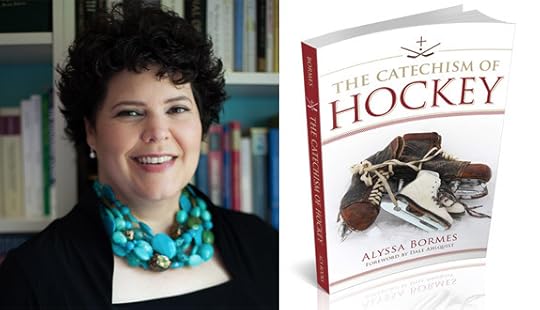
I Went to a Hockey Game...and the Faith Broke Out | David Paul Deavel | CWR |
Alyssa Bormes explains the catechetical possibilities skating right by us in the rink of life
The Duke of Wellington is reported to have said that the Battle of Waterloo was won long before on the playing fields of Eton. Alyssa Bormes doesn't quite say that the Battle of Armageddon will have been won on the backyard hockey rinks of Minnesota, but she's clear in her new book, The Catechism of Hockey (ACS Press, 2013), that she thinks many of the spiritual battles in American Catholic families might be fought better if parents paid more to attention to the analogies to hockey while they explain the analogy of faith.
I know, I know. A whole book on the analogy of hockey to Catholic faith? It sounds like one of those Saturday Night Live sketches that starts well and then drags on for minutes that seem like days. But the book is actually not that long (199 pages) and flows nicely due to Bormes's style. She punctuates her points with parables, personal stories, and historic moments from hockey as well as other sports. What's more, Bormes is able to take on all sorts of topics of faith and morals in a way that makes them more understandable. She understands that arcane dogmas and moral codes are not off-putting: sports parents, especially dads, instinctively catechize their own children in the most obscure quasi-theological topics such as the nature of the infield fly rule, what constitutes pass interference, and what off-side means. Bormes doesn't cite the particular passage in the book, but it's this insight of St. Paul that captured Bormes when she first started to think about sports as a religion: “An athlete is not crowned unless he competes according to the rules” (2 Tim 2:5).
Life Outside of the Rules
I met Alyssa nine years ago when she was taking a course from my wife in the master's program in Catholic Studies at the University of St. Thomas in St. Paul, Minnesota. My wife had told me about a tall, broad-shouldered woman in her class with a great booming laugh, a great heart, and a great mind. Meeting Alyssa was a little like meeting a female Chesterton—deeply faithful, kind to all, and utterly commonsensical. Unlike Chesterton she was even somewhat practical. She certainly broke conventions but was in love with the commandments. But she hadn't always competed in life according to the rules. This Thanksgiving I sat down with her to talk a little bit about her book and her life.
December 8, 2013
Immaculate Mary, Matchless in Grace

Immaculate Mary, Matchless in Grace | John Saward | Two excerpts from Cradle of Redeeming Love: The Theology of the Christmas Mystery
First excerpt, from the Introduction:
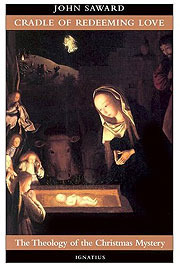 Glorious above all the other Christmas companions of Christ is the Blessed Maiden who gave Him human birth. At the Matins of Christmas Day, the Church cries out: 'Blessed Mary, the Mother of God, whose womb abideth intact, hath this day given birth to the Saviour of the world." [38]
Glorious above all the other Christmas companions of Christ is the Blessed Maiden who gave Him human birth. At the Matins of Christmas Day, the Church cries out: 'Blessed Mary, the Mother of God, whose womb abideth intact, hath this day given birth to the Saviour of the world." [38]
Each day of the octave, in the Canon of the Mass, the Latin Church venerates the 'inviolate virginity' that 'brought the Saviour into this world' and dedicates the whole of the eighth day to the divine motherhood--in the old rite in the content of the prayers and in the new rite in name as well as content. [39] Our Lady's conceiving and carrying of God the Son in her virginal womb are remembered throughout Advent, especially during the week of the O antiphons and, in the novus ordo Missae, on the fourth Sunday.
The Immaculate Conception is celebrated on the eighth of December as the first, preredemptive flowering of the grace for whose restoration Christ was born and crucified in the flesh. In the liturgical books of the Greek Church, the Mother of God is seemingly omnipresent on every day of the liturgical year, [40] but during the twelve days of Christmas, she receives special honours in canticles of outstanding praise, and on the second day she has a feast all of her own, the Synaxis of the Most Holy Theotokos, instituted after the Council of Ephesus in 431. On this second day of the Byzantine Christmas, the Mother of God appears before the Church as the Mystical Vine carrying in the branches of her arms 'the bunch of grapes that was never husbanded'. In the ecstasy of love she sings to her Child, 'Thou art my fruit, thou art my life; from thee have I learned that I remain what I was. Thou art my God: for seeing the seal of my virginity unbroken, I proclaim thee to be the unchangeable Word, now made incarnate.' [41]
Footnotes:
[38] Fifth responsory.
[39] In the novus ordo of the West, the first of January is called the 'Solemnity of Mary; the Mother of God'. In the Missal of 1962 it is called, as it had been for many centuries, the 'Circumcision of Our Lord' because of the passage read as the Gospel. However, both the Collect and the Postcommunion place most emphasis on the divine motherhood of our Lady.
[40] See S. Eustratiadès, Theotokarion (Chennevières-sur-Marne, 1931), and J. Ledit, Marie dans la liturgie de Byzance (Paris, 1976).
[41] Menaion, p. 292.






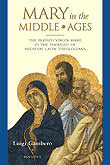



Second excerpt, from Chapter 3, "Mother and Maiden":
As Mother of God, our Lady is without equal, surpassing by far all other created persons, whether angels or men. [37] After the human nature of the Son, no created entity is closer to the Trinity. According to St Thomas, Gabriel's words at the Annunciation, 'The Lord is with thee', express his recognition that the Jewish maiden is closer than he or any other angel is to the Three-Personed God:
She surpasses the angels in her familiarity with God. The angel indicated this when he said, 'The Lord is with thee', as if to say, 'I therefore show thee reverence, because thou art more familiar with God than I am, for the Lord is with thee. The Lord, the Father, is with thee, because thou and He have the same Son, something no angel or any other creature has. "And therefore the Holy which shall be born of thee shall be called the Son of God" (Lk 1: 35). The Lord, the Son, is with thee, in thy womb. "Rejoice and praise 0 thou habitation of Zion, for great is He that is in the midst of thee, the Holy One of Israel" (Is 12:6).' The Lord is therefore with the Blessed Virgin in a different way than He is with the angel, for He is with her as Son, but with the angel as Lord. 'The Lord, the Holy Spirit, is with thee, as in a temple.' Hence she is called 'the temple of the Lord', 'the sanctuary of the Holy Spirit', because she conceived by the Holy Spirit. 'The Holy Spirit shall come upon thee' (Lk 1:35). In this way, therefore. the Blessed Virgin is more familiar with God than the angel is, for the Lord Father, the Lord Son, the Lord Holy Spirit are with her, in other words, the whole Trinity. That is why we sing of her: 'Noble resting-place of the whole Trinity'. [38]
Our Lady is without compare in her objective dignity, and so it is fitting that she should be unrivalled in her subjective sanctity. To prepare her for the task of being Mother to the Son, both physically and spiritually, God the Father bestows upon her an incomparable plenitude of sanctifying grace, the, infused virtues and the Gifts of the Holy Spirit.
St Thomas argues as follows. The nearer something is to any kind of source, the more it shares in the effects of that source. The part of the lawn nearest to the sprinkler will be greener than the more remote parts. Now Christ is the source (grace, as author in His Divinity and as instrument in His humanity, and the Blessed Virgin is closer to Him than ant other creature is, because it was from her that He received His human nature. 'It was therefore necessary for her to receive from Christ a plenitude of grace greater than that anyone else.’ [39]
Even from her conception, she was full of grace. By the anticipated merits of her Son, she was preserved from all stain of Original Sin in the first moment of her conception. Now Original Sin is the privation of sanctifying grace. If, therefore, our Lady was preserved from that privation, if she lacked the lack of grace, she was–putting it positively–endowed in the first moment of her existence with the overflowing fulness of the redeeming grace of her Son. She never lacked grace nor did she ever lose it. By a special privilege she was free from all personal sin, mortal and venial, even from the inclination to sin. All men are sinners, says St Augustine, 'except the Holy Virgin Mary, whom, for the sake of the honour of the Lord, I want to exclude altogether from any talk of sin'. [40]
When, then, we contemplate all the actions that make up our Lady's motherhood, ('Welcome in womb and breast,/ Birth, milk, and all the rest'), [41] we should remember that these humble human realities are endowed, through Mary's supernatural perfections, with a spiritual beauty surpassing that of any other mother in human history. 'And she brought forth her first-born son and wrapped Him up in swaddling clothes and laid Him in a manger, because there was no room for them in the inn' (Lk 2:7).
St Luke's words, by their very simplicity and sobriety, convey something of the supernatural refinement of maternal affection in our Lady's heart. She shows her Son and God that precious virtue which the Middle Ages (including St Thomas) named as 'courtesy' (curialitas), the delicacy of a loving intelligence, the opposite of that crass lack of perception in the man without charity. [42]
These gestures, which other mothers do instinctively and which express their natural love in its.most natural aspects, are done by Mary under the guidance of the Holy Spirit. For these gestures express a love that is not only motherly but virginal, a divine love for her God who is giving Himself to her in the weakness, the littleness of the Little One, handed over totally to His Mother. Under the movement of the Gifts of Fear, Piety, and Counsel, Mary carries out these actions in a divine way. It is with a chaste and loving fear, in perfect abandonment to the Father's will, that she clasps her Child to her heart, to warm the tiny and tender limbs of the only Son of the Father.... No mother has clasped her baby to her heart with more tenderness than Mary; no mother has had more delicacy and respect for the frailry of her baby. [43]
Footnotes:
[37] 'It is impossible for a pure creature to be raised to a higher degree. By the grace of her motherhood, she exhausts, so to speak, the very possibility of a higher elevation' (Charles de Koninck, Ego sapientia: La sagesse qui est Marie [Montreal, 1943], p. 39).
[38] In salutationem angelicam, a. 1.
[39] Cf ST 3a q. 27, a. 5.
[40] De natura et gratia cap. 42, no. 36; PL 44:267.
[41] Gerard Manley Hopkins SJ, 'The Blessed Virgin Compared to the Air We Breathe', The Poems of Gerard Manley Hopkins, ed. W H. Gardner & N. H. Mackenzie, new ed. (London, 1970), p. 94.
[42] The anonymous author of the fourteenth-century poem Pearl calls our Lady 'the Queen of Courtesy': see Sir Gawain and the Green Knight, Pearl, and Sir Orfeo, trans. J. R. R. Tolkien, new ed. (New York, 1980), p. 111. 'Great is the courtesy', says St Thomas, 'when the King of Kings and Lord of Lords invites us to His nuptials' (Sermo 1, pt. 3).
[43] M.-D. Philippe OP, Mystére de Marie: Croissance de la vie chréitienne (Nice, 1958), p. 145. According to the Revelations of St Bridget of Sweden, when the Blessed Mother saw her newborn Son shivering with cold, she 'took Him in her arms and pressed Him to her breast, and with her face and breast warmed Him with great gladness and tender motherly compassion': Revelationes , lib. 7, cap. 21; new ed., vol. 2 (Rome, 1628), p. 231.
Related IgnatiusInsight.com Articles:
• "Hail, Full of Grace": Mary, the Mother of Believers | Joseph Cardinal Ratzinger
• Excerpts from The Rosary: Chain of Hope | Fr. Benedict Groeschel, C.F.R.
• "Conceived by the Holy Spirit, born of the Virgin Mary" | Hans Urs von Balthasar
• The Past Her Prelude: Marian Imagery in the Old Testament | Sandra Miesel
• The Medieval Mary | The Introduction to Mary in the Middle Ages | by Luigi Gambero
• Misgivings About Mary | Dr. James Hitchcock
• Mary in Feminist Theology: Mother of God or Domesticated Goddess? | Fr. Manfred Hauke
• Assumed Into Mother's Arms | Carl E. Olson
• The Disciple Contemplates the Mother | Erasmo Leiva-Merikakis
Advent/Marian Series (2004) by Carl E. Olson:
• Mary's Gift of Self Points the Way (November 28, 2004)
• The Perfect Faith of the Blessed Virgin (December 5, 2004)
• Theotokos sums up all that Mary is (December 12, 2004)
• Holy Mary and the Death of Sin (December 19, 2004)
 Fr. John Saward (b. 1947) is a fellow of Greyfriars and associate lecturer of Blackfriars at the University of Oxford. He previously held the posts of Professor of Dogmatic Theology in the International Theological Institute, Gaming, Austria and Visiting Professor in Systematic Theology and Christology in the same Institute. Ordained as an Anglican clergyman in 1972, he and his family were received into the Catholic Church in 1979 at Campion Hall, Oxford. He is the author of several books, including The Way of the Lamb: The Spirit of Childhood and the End of the Age, Cradle of Redeeming Love: The Theology of the Christmas Mystery, Redeemer in the Womb, and The Beauty of Holiness and the Holiness of Beauty: Art, Sanctity, and the Truth of Catholicism. He has also translated several works, including Hans Urs von Balthasar's Scandal of the Incarnation: Irenaeus Against the Heresies. Fr. Saward also contributed an essay to John Paul the Great: Maker of the Post-Conciliar Church.
Fr. John Saward (b. 1947) is a fellow of Greyfriars and associate lecturer of Blackfriars at the University of Oxford. He previously held the posts of Professor of Dogmatic Theology in the International Theological Institute, Gaming, Austria and Visiting Professor in Systematic Theology and Christology in the same Institute. Ordained as an Anglican clergyman in 1972, he and his family were received into the Catholic Church in 1979 at Campion Hall, Oxford. He is the author of several books, including The Way of the Lamb: The Spirit of Childhood and the End of the Age, Cradle of Redeeming Love: The Theology of the Christmas Mystery, Redeemer in the Womb, and The Beauty of Holiness and the Holiness of Beauty: Art, Sanctity, and the Truth of Catholicism. He has also translated several works, including Hans Urs von Balthasar's Scandal of the Incarnation: Irenaeus Against the Heresies. Fr. Saward also contributed an essay to John Paul the Great: Maker of the Post-Conciliar Church.
"Mary Immaculate" by Fr. Kenneth Baker, SJ

Mary Immaculate | Fr. Kenneth Baker, S.J. | A Homily for the Feast of the Immaculate Conception
Immaculate Conception—December 8 (transferred to Dec. 9, 2013) | Readings: Gen. 3:9-15, 20 | Eph. 1:3-6, 11-12 | Luke 1:26-38
[Note: This homily originally appeared the November 2007 issue of Homiletic & Pastoral Review.
We live in a world abounding in sin and sinners. But it is a world that denies the existence of sin. Why is that? Because sin is an offense against God, and many do not believe in God. Therefore, if there is no God, there cannot be any sin. But we are surrounded by sin and read about it and see it in the news media every day—murder, adultery, abortion, sodomy, theft, lies and so forth. Because of original sin and concupiscence, in various ways we all offend God, some mortally and some venially. Today, however, we celebrate the feast of one of us, one woman, who never committed a sin—Mary of Nazareth, the Immaculate Mother of God.
What is the meaning of the term, "Immaculate Conception"? It does not mean the conception of Jesus. It refers to the conception of Mary in the normal way through the marital embrace of her parents, St. Anne and St. Joachim. Because of the first sin of Adam and Eve, all human beings are conceived without sanctifying grace, the life of the soul. Since the coming of Christ, we can attain grace through baptism, but we are conceived and born without God's grace. The Church teaches that God endowed Mary's soul with grace from the first moment of her creation, so she was never under the power of original sin.
"Immaculate" means without stain. Since sin is a "stain" on the soul, which should be pure in the sight of God, the Church believes that Mary was conceived without the "stain" of original sin, which means the lack of God's grace. One proof of this is taken from the greeting of the angel Gabriel to Mary, "Hail, Mary, full of grace..." (Luke 1:28). Because she was full of grace, Mary was most pleasing to God in all she was and did.
The prayers of today's Mass stress that Mary was "preserved" from sin. Jesus died on the Cross, rose from the dead and accomplished our redemption. He is the fountain of supernatural life for us. We partake of that through faith, baptism and the sacraments. So the Church teaches that Mary was preserved from original sin by the foreseen merits of Jesus, her son and her redeemer. Mary is, therefore, the first redeemed, the first Christian; she is perfectly redeemed in every way—in soul and body and emotions.
Mary had a special mission in the redemption of mankind. So God created her as a "fitting dwelling place" for his son Jesus, who crushed the head of Satan (Gen. 3:15); Satan never had any power over him. He was to be born of a woman who was totally free from sin, never under the power of the devil. Just as God prepared a sinless paradise for Adam and Eve, so Mary is a "second" sinless paradise where the Son of God will dwell nine months before his birth in Bethlehem.










The Fathers compare Mary with Eve. In their view, which is based on divine revelation in the Bible, Eve is the mother of all the living—she gave us both life and death. Mary is the true mother of all the living—those who live spiritually forever through her son. That is why she is also called "Mother of the Church."
We were all conceived by our parents with original sin. Only Mary was immaculately conceived. In a sense, this phrase sums up the total reality of Mary and implies our whole Catholic faith in Jesus—Son of God and Savior.
When little Bernadette asked the beautiful lady at Lourdes her name, she said, "I am the Immaculate Conception." The poet got it right when he summed up the reality of Mary in five words: "Our tainted nature's solitary boast."
Because she gave birth to the Savior, Mary is our mother in the order of grace. In every way she cooperated with God in the redemption: "Behold the handmaid of the Lord. Let it be done to me according to thy word" (Luke 1:38). Thus she was totally open to God, available, humble and obedient.
Children naturally tend to imitate their parents. We see in Mary all the virtues of a perfect Christian. We should strive to imitate her, since she is our mother. We should strive to imitate her faith, her hope and her love—her love for Jesus and her willing cooperation in his work of redemption, even to offering him to the Father on Calvary.
We should strive to imitate her sinlessness by avoiding all mortal sin and all deliberate venial sins. We should ask her to obtain for us the grace to avoid all deliberate sins—so we can be a "fitting dwelling place" for divine grace.
In the New Testament Mary's last recorded words at Cana are, "Do whatever he tells you" (John 2:5). If we love God, we should try to do that. When we receive God's Son and Mary's son in Holy Communion today, let us say to him: "Be it done to me as you desire."
"O Mary, conceived without sin, pray for us who have recourse to thee."
Suggested reading: Catechism of the Catholic Church , 411, 490-493.
Related IgnatiusInsight.com Articles on Advent and Christmas:
• Come, Lord Jesus! The Meaning of Advent | Fr. Kenneth Baker, S.J.
• Archbishop Fulton Sheen on Advent | From Through the Year With Fulton Sheen
• Mary's Gift of Self Points the Way | Carl E. Olson
• Immaculate Mary, Matchless in Grace | John Saward
• The Medieval Mary | The Introduction to Mary in the Middle Ages | by Luigi Gambero
• The Mystery Made Present To Us | Fr. Alfred Delp, S.J.
• Remembering Father Alfred Delp, S.J., Priest and Martyr | A Conversation with Father Karl Adolf Kreuser, S.J.
• Assumed Into Mother's Arms | Carl E. Olson
• The Disciple Contemplates the Mother | Erasmo Leiva-Merikakis
• The Incarnation | Frank Sheed
• "Born of the Virgin Mary" | Paul Claudel
• The Old Testament and the Messianic Hope | Thomas Storck
• Christmas: Sign of Contradiction, Season of Redemption | Fr. James V. Schall, S.J.
• The God in the Cave | G.K. Chesterton
St. John the Baptist, "angelic" guardian of Advent
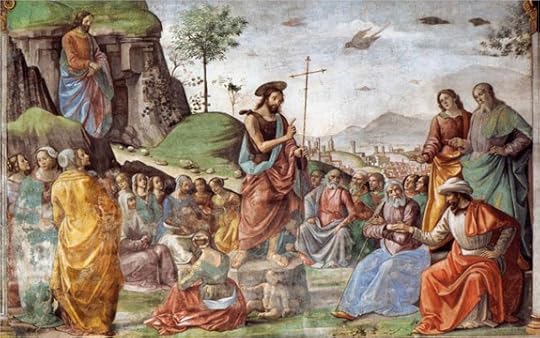
"The Preaching of St. John the Baptist" by Domenico Ghirlandaio (1490)
A Scriptural Reflection on the Readings for Sunday, December 8th, Second Sunday of Advent | Carl E. Olson
Readings:
• Isa 11:1-10
• Ps 72:1-2, 7-8, 12-13, 17
• Rom 15:4-9
• Mt 3:1-12
[Note: The Solemnity of the Immaculate Conception of the Blessed Virgin Mary, Patronal Feastday of the United States of America, is transferred, in the U.S. to Monday, December 9th.]
The season of Advent, wrote Fr. Hans Urs von Balthasar in You Crown the Year with Your Goodness (Ignatius Press, 1989), is like a gate through which the Christian “passes to enter some shrine. This gate is flanked by two figures guarding it …” These two persons, he added, “ask us why and with what intentions we are seeking admission.”
In other words, Advent is not simply about the past, as if we are merely remembering some important but ancient event. It is just as much about the present and the future, for it has to do with the sweeping, mysterious panorama of salvation history. And these two great saints—John the Baptist and Mary, the Mother of God—are not lost or trapped in time, but are alive today, preparing us—if we are willing to listen and respond—for the arrival of the Messiah.
John the Baptist “stands tall and straight, haggard, an angel clothed in camel’s hair, who wants to be nothing but a Voice resounding through the wilderness of the world, the desert of time.” Why did von Balthasar call John the Baptist an “angel”? Because an ángelos is a messenger specifically send by God to prepare the way for the word of the Lord (cf. Mk. 1:2). John was the voice who announced the Word; he proclaimed a message of preparation for the One who would baptize with the Holy Spirit and fire.
John was both fiercely bold and thoroughly humble, a combination also found in Elijah, Isaiah, Jeremiah, and the other Old Testament prophets. He knew who he was and what he was called to do; his identity and mission were perfectly joined in a singular focus on the Messiah. Even before being born, while yet in the womb, he leapt at the voice of the God-bearer, the blessed Virgin Mary (Lk. 1:41), as if to say, “I am ready to speak, to announce, to proclaim!” But it was Mary, the mother of the Lord, who first proclaimed, “My soul magnifies the Lord, and my spirit rejoices in God my Savior…” (Lk. 1:46-47). John and his mission gestated a while longer, waiting for nature to take its course and the supernatural to set his course.
John’s time finally arrived some thirty years later when he emerged from the Judean desert, clothed in camel’s hair and girt with a leather belt. His message can be summarized in a single word: “Repent!” And that is the message he continues to announce during Advent, always pointing to Christ with a piercing single-mindedness. “He prepared the souls of believers,” wrote St. Jerome of the Baptizer, “in whom the Lord would walk…”
He stands today, a wild and mysterious figure, demanding that we recognize how close is the kingdom of heaven and exhorting us to open our hearts to the King. “He sets an example for all Christians,” remarked von Balthasar, “all apostles, priests, all who proclaim Christ: none of them may proclaim themselves, chatter about their own religious experience: they are to be only the voice of him who is ‘increasing’, who is always greater.”
John said that the one who was coming after him would bring unquenchable fire. That fire is the “transforming energy of the Holy Spirit’s actions” (Catechism, par. 696). It is the divine life that burns away the chaff of temporality and passing things while revealing all that is holy and eternal. “For the power of fire is deemed to be beneficial and strong,” noted St. Theodore of Heraclea, “destructive of evil things and preservative of what is better.” God, after all, is a devouring fire (Dt. 4:24).
Shortly before being arrested and martyred, John spoke to his disciples about Jesus, saying, “He must increase, but I must decrease” (Jn. 3:30). As Advent unfolds and Christmas approaches, we are challenged to decrease, allowing the chaff of our sins and selfishness to be burned away while opening our hearts to filled with the Word, the Lord Jesus Christ.
(This "Opening the Word" column originally appeared in the Dec. 5, 2010, issue of Our Sunday Visitor newspaper.)
December 6, 2013
You Better Watch Out—St. Nicholas is Coming to Town
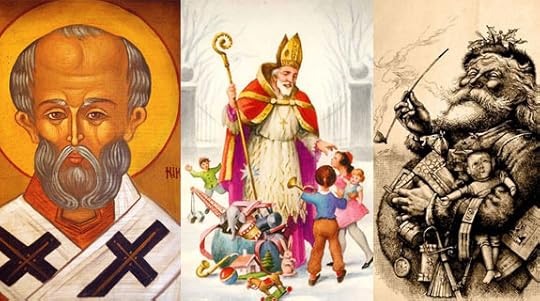
The seldom-told stories of St. Nicholas the Wonderworker | Christopher B. Warner | CWR
Everyone loves jolly ol’ Saint Nicholas. There is something romantic and cozy about telling Santa stories around the crackling fire. He is an icon of the Christmas season. But not everyone agrees about the real Santa Claus. Some like to picture Santa as the early-19th century, pipe-smoking elf with a bucket full of coal for naughty boys who don’t eat their cauliflower. Others prefer Santa as an emasculated, overweight consumer who gets bossed around by Mrs. Claus and thus flees the North Pole once a year to relive the glory days. Then there is the wiry bishop who pulled Arius’ beard and punched him in the face for teaching heresy. Maybe they’re all the same guy. A 1,700-year-old hero can’t be expected to fit into just one old Santa suit. Our images of St. Nicholas seem to evolve or deteriorate based on the values of contemporary culture in different times and places.
In 1809, Washington Irving wrote Knickerbocker’s History of New York, a work of imaginative fiction that included several tales about a jolly, elfin Dutchman scampering down chimneys to bring gifts to children. The American image of Santa Claus was solidified during this time period. “A Visit from St. Nicholas,” a poem by Clement Clarke Moore published in 1823 and better known as “’Twas the Night Before Christmas,” introduced the enduring image of Santa’s reindeer and sleigh and fixed the date of his visit to Christmas Eve. These are fun stories that make up an important part of our literary tradition and culture in America. However, stuffing chimney-hung stockings is an ancient tradition that pre-dates the American elf lore as well as the Dutch, who fill their children’s wooden clogs with gifts the night before St. Nicholas Day (December 6). Chucking gold into people’s wet socks is a custom started by a young man named Nicholas who lived in Asia Minor around 300 AD.
There are hundreds of stories about St. Nicholas of Myra. He was born in Lycia on the southwest coast of modern Turkey. His wealthy, pious parents, Theophanes and Nonna, read to him the Holy Scriptures and faithfully taught him his prayers, but apparently died while he was still young. His uncle, Bishop Nicholas of Patara, ordained young Nicholas and made him his personal assistant. The zealous youth proved himself an inspiring catechist in the Christian community and an obedient servant to his uncle. During these dutiful years he showed great kind-heartedness and generosity by distributing his inheritance to the poor.
During this time, the three grown daughters of a formerly rich inhabitant were in danger of being sold into slavery because of their father’s pennilessness.
Fr. Edward T. Oakes, SJ, Requiescat in pace
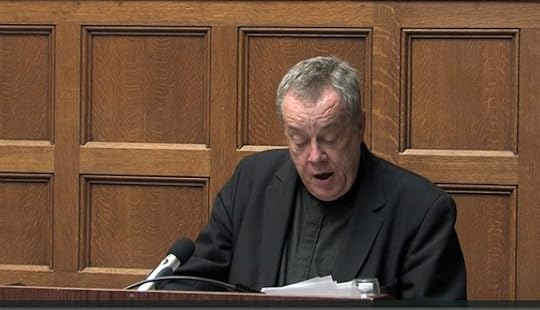
Fr. Edward Oakes, SJ, giving a lecture in 2012 at the Lumen Christi Institute
From David Mills of First Things, this sad news:
Father Edward Oakes, S.J., distinguished theologian, gifted writer and teacher, generous ecumenist, and our friend, has died, of pancreatic cancer, at 8:00 this morning.
Mills provides some biographical information courtesy of the Academy of Catholic Theology, "of which Father Oakes was president":
Father Oakes entered the Society of Jesus in 1966, and was ordained a priest in 1979. He received his doctorate in theology from Union Theological Seminary in 1987. He taught at New York University, Regis University, and Mundelein Seminary, where he was deeply loved and valued by his colleagues, students, and indeed everyone on the staff as well.
He was a major contributor to the ecumenical magazine First Things on theological and scientific topics, and a longtime close friend of Father Richard John Neuhaus. For close to two decades he was an influential member of Evangelicals and Catholics Together. He was a founding member of the Academy of Catholic Theology and was elected president of the Academy in May 2013.
A deeply cultured man, Father Oakes enlivened everything of which he was a part by his penetrating intelligence and warm, friendly spirit. He was an esteemed translator of the works of Hans Urs von Balthasar and others. He was the author and editor of important works such as Infinity Dwindled to Infancy: A Catholic and Evangelical Christology, Pattern of Redemption: The Theology of Hans Urs von Balthasar, and The Cambridge Companion to Hans Urs von Balthasar.
To say that Father Oakes will be sorely missed is a profound understatement. Let us pray for his soul as he enters into the infinitely loving communion of the Father, Son, and Holy Spirit, as an adopted son in Jesus Christ!
I did not know Fr. Oakes personally, but have read with great profit many of his essays over the years (here is a listing of some of his writings). This past summer, I e-mailed Fr. Oakes and invited him to participate in the CWR Symposium on "Vatican II, Salvation, and the Unsaved". He replied:
Thank you very much for your kind invitation. Unfortunately, I have recently been diagnosed with cancer; so I must regretfully decline. The attached circular letter to my fellow Mo Prov. Jesuits will explain the details. You are free to share this news with the rest of your staff; but it should not be made public in your news site, as it would result in more messages than I think I can handle at the moment.
Please keep me in your prayers. I am now reading the fine biography of Augustus Tolton from Ignatius Press, so don't forget to ask for his intercession!
In his letter to his fellow Jesuits, Fr. Oakes reiterated his request for prayers for the intercession of Fr. Tolton:
How about we all pray for the intercession of Fr. Augustus Tolton? His cause is now being promoted by the Archdiocese of Chicago. He was the first African-American priest in the United States, and much abused by the racism of his day, to such an extent he had to forsake the Archdiocese of Chicago for Quincy, Illinois. (I like the irony that his cause is now being promoted by his erstwhile nemesis!) But he never lost his faith in God, or his zeal for souls, or his love for the Church – and he never lost his love for his people, whether they loved him or despised him. Terar dum prosim indeed: “Let me be worn out, so long as I can serve.”
Please consider saying a prayer for the respose of the soul of Fr. Oakes, a great scholar, teacher, writer, and Jesuit. May God grant him mercy and eternal memory!
[Note: The photo of Fr. Oakes above is from a video of a lecture he gave in 2012 on Vatican II for the Lumen Christi Institute.]
December 5, 2013
Archbishop Fulton Sheen on Advent and Eternity (Dec. 5-11)

Archbishop Fulton Sheen on Advent and Eternity
Through the Year with Fulton Sheen is Sheen at his best—the master storyteller, preacher, and faithful servant of Christ—with a word of encouragement, counsel, and direction for each day of the year. With characteristic insight and eloquence, he penetrates to the heart of the Christian life with practical reflections on love, holiness, spiritual power, miracles, and Christ-like living. These daily selections provide a fresh perspective on what it means to be a follower of Christ, on the challenge of serving God and the blessings of living a grace-filled life.
Here are the daily selections for the second week of Advent.
Eternity | December 5
Why must heaven be outside of time? Simply because none of us would want an endless existence on this earth. If it were possible for us to live four hundred years with some kind of vitamin, do you think that we would all 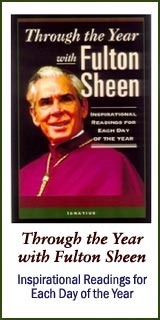 swallow them? There would certainly come one moment in our existence when we would want to die. Have you ever been in any one place on this earth that you were absolutely sure would be one in which you would want to spend every day of your life? It is not very likely. The mere extension of time to most of us would probably be a curse instead of a blessing. Then, too, have you ever noticed that your happiest moments have come when eternity almost seems to get inside of your soul? All great inspirations are timeless, and that gives us some suggestion of heaven. Mozart was once asked when he received his inspirations for his great music. He said he saw them all at once in a great heat, a great warmth, a great light. Then there came the succession of notes. So it is in writing a speech. When I prepare a talk, or a telecast, or a book, there comes a moment when the end is seen at the beginning. One cannot write fast enough. There comes to everyone, whether he is good or bad, some dim intimations of immortality such as Wordsworth wrote about. There are, however, men who try to immunize themselves from these thoughts of eternity. They put on a kind of God-proof raincoat, so that the drops of his grace will not get through to them. They shut out eternity.
swallow them? There would certainly come one moment in our existence when we would want to die. Have you ever been in any one place on this earth that you were absolutely sure would be one in which you would want to spend every day of your life? It is not very likely. The mere extension of time to most of us would probably be a curse instead of a blessing. Then, too, have you ever noticed that your happiest moments have come when eternity almost seems to get inside of your soul? All great inspirations are timeless, and that gives us some suggestion of heaven. Mozart was once asked when he received his inspirations for his great music. He said he saw them all at once in a great heat, a great warmth, a great light. Then there came the succession of notes. So it is in writing a speech. When I prepare a talk, or a telecast, or a book, there comes a moment when the end is seen at the beginning. One cannot write fast enough. There comes to everyone, whether he is good or bad, some dim intimations of immortality such as Wordsworth wrote about. There are, however, men who try to immunize themselves from these thoughts of eternity. They put on a kind of God-proof raincoat, so that the drops of his grace will not get through to them. They shut out eternity.
Heaven is in here | December 6
Too often we think of heaven as being way out there. We draw all kinds of pictures about heaven. Most of them are quite unreal, and because we think of heaven, and even hell, as something that happens to us at the end of time, we keep on postponing it. As a matter of fact, heaven is not way out there; heaven is in here. Hell is not way down there; hell could be inside of a soul. There is no such thing as dying and then going to heaven, or dying and going to hell. You are in heaven already; you are in hell already. I have met people who are in hell. I am sure you have too. I have also seen people with heaven in them. If you ever want to see heaven in a child, look at that child on the day of his first communion. If you want to see how much love is related to heaven, just look at the bride and groom at the altar on the day of the nuptial Mass. Heaven is there; heaven is there because love is there. I have seen heaven in a missionary nun who was spending herself among the lepers.
Sometimes you see a virtuous young person and you see heaven there. The beauty of such a person is not put on the outside, it is a kind of imprisoned loveliness that comes from within, as if it were breaking down the bars of flesh in order to find some outward utterance.
A man who wanted to go to hell | December 7
I remember once attending a man in a hospital. When I asked him to make his peace with God he said, "I suppose you’re going to tell me I’m going to hell."
"No," I said, "I’m not."
"Well," he said, "I want to go to hell."
I replied, "I have never in my life met a man who wanted to go to hell, so I think I will just sit here and watch you go." Of course, I did not intend to let time pass without doing something, but I was absolutely sure that if he had a few minutes to himself, he might change his point of view. So I sat alone with him for twenty minutes. I could see him going through a kind of soul struggle.
Then he said to me, "You really believe there is a hell?"
I asked him, "Do you feel unhappy on the inside? Are you fearful? Is there dread, anxiety? Are all the evil things of your life coming up before you as a specter, a ghost?" Well, it was not long until he made his peace with God.






Why the virgin birth? | December 8
Our human nature was very much like a polluted stream up until the Incarnation. Imagine a ship, for example, sailing in polluted waters. It wishes to sail in clear waters, but without the pollution coming from one into the other. How could the transfer of the ship be made except by a lock? So the ship in the foul waters would be put into a lock where there would be a separation of waters, then the ship would be raised to the level of the unpolluted waters. Now the Immaculate Conception and the virgin birth were that lock. The pollution stopped because there was no union of man and woman. It was simply woman alone who gave a human nature to Christ and began the new humanity.
Heaven grows in us | December 9
Heaven is very close to us because heaven is related to a good life in much the same way that an acorn is related to an oak. An acorn is bound to become an oak. He who does not have heaven in his heart now will never go to heaven, and he who has hell in his heart when he dies will go to hell. We must not think that heaven is related to a good life in the same way a gold medal is related to study. Because a gold medal need not follow study. It is purely extrinsic to study. Rather, heaven is related to a good and virtuous life in just the same way that knowledge is related to study. One necessarily follows the other. Hell is not related to an evil life in the same way that spanking is related to an act of disobedience. Spanking need not follow an act of disobedience. As a matter of fact, it rarely follows disobedience today. Rather, it is related in the same way that corruption is related to death. One necessarily follows the other. Therefore, heaven is not just a long way off, we are not to postpone it. It is here. That is to say, it begins here.
Like the Israelites in the desert | December l0
Heaven starts here, but it doesn’t end here. We just get faint glimpses of it now and then. If we postpone the thought of heaven until the moment we die, we will be very much like the Israelites during their wanderings in the desert. They were at one time within about eleven days of the promised land. It took only three weeks for them to make the journey from Egypt to the promised land, but because of their disobedience, their failures, their backsliding, and their rebellion against Moses, it took them forty years to get into the promised land. That forty years represents a pilgrimage in the lives of most of us. We make progress, and then we slip back. Thank heavens we have a merciful Lord who puts up with us and forgives us seventy times seven. Therefore, time is necessary in order to gain heaven, but the lapse of time itself does not bring me to heaven. What brings me to heaven is how I live, how I die.
I go to prepare a place | December 11
Now we come to what our Lord said about heaven. It was the night of the Last Supper. Jesus gathered about him all his apostles-poor, weak, frail men. He washed their feet. He was facing the agony in the garden, and that terrible betraying kiss of Judas, and even the denial of Peter himself. One would think that all the talk would be about himself. Certainly, when we have trials, that is what we think about. But our Lord thought about the apostles. He saw the sadness in their faces, and he said, "Be not troubled, do not be sad, I go to prepare a place for you. In my father’s house there are many mansions." How did he know about the Father’s house? He came from there. That was his home. Now preparing to go back home, he tells them about the Father’s house and he says, "I go to prepare a place for you." God never does anything for us without great preparation. He made a garden for Adam, as only God knows how to make a garden beautiful. Then, when the Jews came into the promised land, he prepared the land for them. He said he would give them houses full of good things, houses which they never built. He said that he would give them vineyards and olive trees which they never planted. just so, he goes to prepare a place for us. Why? Simply because we were not made for heaven; we were made for earth. Man, by sin, spoiled the earth, and God came down from heaven in order to help us remake it. After having redeemed us, he said that he would now give us heaven, so we got all this: the earth, and heaven too.
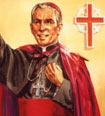 Archbishop Fulton Sheen (1895-1979) is considered by many to be the most influential Catholic of the 20th century in America.
Archbishop Fulton Sheen (1895-1979) is considered by many to be the most influential Catholic of the 20th century in America.
Millions of people watched his incredibly popular television series every week, "Life is Worth Living", and millions more listened to his radio program, "The Catholic Hour". Wherever he preached in public, standing-room-only crowds packed churches and halls to hear him. He had the same kind of charisma and holiness that attracts so many people to Pope John Paul II, who called Sheen "a loyal son of the Church."
Learn more about Archbishop Sheen by reading his autobiography, Treasure In Clay, or visiting the Archbishop Fulton J. Sheen Foundation website.
20% off for Advent & the feasts of the Immaculate Conception and Our Lady of Guadalupe
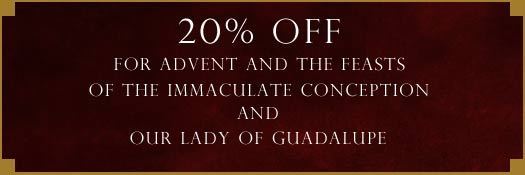
Offer ends Wednesday, December 11th, 2013 at 12:00 midnight EST.
These prices are available online only through Ignatius.com
20% off of meditations for Advent, titles that explore the life of Mary
and her apparition to her children at Guadalupe!
"Advent’s intention is to awaken the most profound and basic emotional memory within us, namely, the memory of the God who became a child. This is a healing memory; it brings hope...It is the beautiful task of Advent to awaken in all of us memories of goodness and thus to open doors of hope."
— Joseph Ratzinger (Pope Benedict XVI), from his book Seek That Which Is Above: Meditations on Major Feasts
Advent
“This should be our first Advent light: to understand everything, all that happens to us and all that threatens us, from the perspective of life's character of waiting. We must endure all the blessedness and un-blessedness of waiting because we are underway... 'Those who really wait for Him will not be disappointed.'”
— Fr. Alfred Delp, S.J.
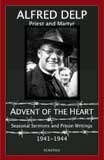 Advent of the Heart
Advent of the Heart
Alfred Delp
Accused of conspiring against the Nazi government, Fr. Alfred Delp, S.J., a heroic german Jesuit priest, was arrested in 1944, tortured, imprisoned, and executed on Feb 2, 1945. While in prison, Fr. Delp was able to write a few meditations found in this book, which also includes his powerful reflections from prison during the Advent season about the profound spiritual meaning and lessons of Advent, as well as his sermons he gave on the season of Advent at his parish in Munich. These meditations were smuggled out of Berlin and read by friends and parishioners of St. Georg in Munich.
His approach to Advent, the season that prepares us for Christmas, is what Fr. Delp called an "Advent of the heart." More than just preparing us for Christmas, it is a spiritual program, a way of life. He proclaimed that our personal, social and historical circumstances, even suffering, offer us entry into the true Advent, our personal journey toward a meeting and dialogue with God. Indeed, his own life, and great sufferings, illustrated the true Advent he preached and wrote about.
From his very prison cell he presented a timeless spiritual message, and in an extreme situation, his deep faith gave him the courage to draw closer to God, and to witness to the truth even at the cost of his own life. These meditations will challenge and inspire all Christians to embark upon that same spiritual journey toward union with God, a journey that will transform our lives. Also available as an e-book.
Regular price: $14.95, sale price: $11.96
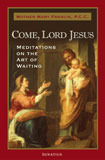 Come, Lord Jesus: Meditations on the Art of Waiting
Come, Lord Jesus: Meditations on the Art of Waiting
Mother Mary Francis, P.C.C.
These Advent reflections by the abbess of a Poor Clare monastery, an accomplished spiritual writer, focus our attention on the coming of Jesus into our lives. There is a double movement to this coming; both our active preparation to be ready for him and our patient waiting for the Lord to arrive in his own good time. There is also an art to this simultaneous preparation and waiting, and no one knows better than the beloved Mother Mary Francis how to encourage us in our attempts to master this art.
Meditating on passages from Scripture about the coming of the Messiah into the world and our hearts, Mother challenges us to persevere in overcoming our faults and keeping our eyes on the Lord who has called us to himself-for it is he, through the gifts of his grace, who will complete in us the work of sanctification which he has begun.
Though written for Advent, the wisdom of Mother Mary Francis collected by her sisters is profitable at any time because a Christian life is one of constant growth into the very likeness of God. Also available as an audio download and e-book.
Regular price: $15.95, sale price: $12.76
The Immaculate Conception
"Preparing for the advent of the year 2000, the great memorial of Christ's birth, is a fundamental concern of the encyclical [Mary God's Yes to Man]. In the liturgy, Advent is a Marian time: the time when Mary made room in her womb for the Savior of the world and bore within her humanity's hope and expectation. Celebrating Advent means becoming Marian, imitating Mary's unconditional Yes which is ever anew the place of God's birth, the 'fullness of time'"
— Joseph Ratzinger (Pope Benedict XVI)
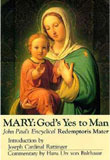 Mary: God's Yes to Man
Mary: God's Yes to Man
Pope John Paul II
Pope John Paul II's only encyclical on our Blessed Mother, with introduction by the Cardinal Prefect of the congregation for the Doctrine of the Faith, Cardinal Joseph Ratzinger, and commentary by one of the world's leading Catholic theologians, Hans Urs von Balthasar. The Church's supreme magisterium and representative of the Church's most penetrating theological reflection combine to provide for all the faithful a rich and concise compendium of the Mother of the Redeemer.
The development of traditional Marian dogma in the light of the present day bears the Pope's unmistakable personal stamp. The three parts of the encyclical ("Mary in the Mystery of Christ", "The Mother of God in the Midst of the Pilgrim Church" and "Motherly Mediation") draw predominantly from two sources: Sacred Scripture and the central documents of the Second Vatican Council. There is a particular emphasis on ecumenism. What binds all Christians to Mary becomes ever clearer: she is the model of their faith.
Regular price: $10.95, sale price: $8.76
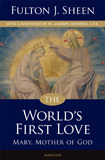 The World's First Love (2nd edition)
The World's First Love (2nd edition)
Archbishop Fulton J. Sheen
With his characteristic eloquence and brilliance, Fulton J. Sheen presents a moving portrayal of the Blessed Virgin Mary that combines deep spirituality with history, philosophy and theology. All the major aspects and events of Mary's life are lovingly portrayed in this word portrait that is a never failing source of information, consolation and inspiration. Sheen also gives profound insights into all the Marian beliefs ranging from the Immaculate Conception to the Assumption to the miracle of Our Lady of Fatima.
While considering the different phases of Mary's life, Bishop Sheen discusses various problems common to mankind of every age and reveals clearly that every problem can be resolved. He emphasizes the unique dignity, strength and gifts of women and their ability to help heal the world's problems. Sheen stresses mankind's need of the Mother of God and her burning love for all her children. The great resurgence of devotion to Mary is God's way of emphasizing the worth and dignity of every person against the false doctrines that have so confused the modern world. Also available as an audio download and e-book (first edition).
Regular price: $16.95, sale price: $13.56
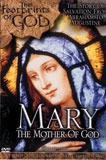 Footprints of God: Mary
Footprints of God: Mary
This second film in the the Footprints of God series follows Mary on her extraordinary journey on location in Turkey, Israel and Greece with popular Catholic author and speaker Stephen Ray as guide. Down-to-earth teaching on subjects like Mary’s Immaculate Conception, Assumption into Heaven, and her role of intercessor, and more are offered in an energized, high-impact style that combines the best elements of a travel documentary, biography, Bible study, apologetics course, and church history review.
Regular price: $24.95, sale price: $19.96
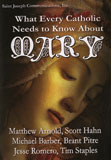 What Every Catholic Needs to Know About Mary
What Every Catholic Needs to Know About Mary
Now, you'll be empowered with the truth about such important Marian topics as her Divine Maternity, Perpetual Virginity, Immaculate Conception, and Bodily Assumption into Heaven. Plus, you will learn the crucial role that the Church's Traditional Biblical interpretation regarding the Blessed Virgin plays in understanding her role in the Church today. Perfect for adult inquiry classes, RCIA, Confirmation and Catholic Bible study groups. With this inspiring and enlightening presentation, you'll have a powerful and "painless" way to share the essential truths about the Blessed Virgin Mary. With Matthew Arnold, Scott Hahn, Michael Barber, Brant Pitre, Jesse Romero, and Tim Staples.
Regular price: $19.95, sale price: $15.96
Our Lady of Guadalupe
“Do not be troubled or weighed down with grief. Do not fear any illness or vexation, anxiety or pain. Am I not here who am your mother? Are you not under my shadow and protection? Am I not the Fountain of Life? Are you not in the folds of my mantle, in the crossing of my arms? Is there anything else you need?”
— Our Lady of Guadalupe to St. Juan Diego on December 12, 1531
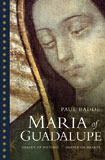 Maria of Guadalupe: Shaper of History, Shaper of Hearts
Maria of Guadalupe: Shaper of History, Shaper of Hearts
Paul Badde
Mexico, December 9, 1531. Ten years after the Spaniards conquered this land, on a hill on the outskirts of the capital, something inconceivable happens to Juan Diego, a native of the area. At dawn a heavenly figure comes to meet him, revealing herself as “Mary, mother of all men”. To confirm the first vision, the Lady not only entrusts him with several messages. But, also, in the final vision, leaves her portrait mysteriously present on his tilma. It is the portrait of a young woman looking downward. She is clothed in a dress figured with roses and a mantle spangled with stars.
From the time of its occurance this event has moved people. However, because of the fascination with the image itself, doubts have been raised, causing some to reject it altogether. This image of Our Lady of Guadalupe, along with the Shroud of Jesus in Turin, have possibly become the most mysterious images on earth. The more studies are made of the image and of the cloth, the more mysterious it all becomes, for believers and scientists alike.
In a hands-on investigation, Paul Badde has been delving into this mystery from a historian’s point of view, but also with the growing wonder of a journalist who has stumbled across a fabulous treasure.
In this heartfelt report, Paul Badde tells the fantastic story of the apparition that changed the history of the world. Only in light of this mysterious event, can one explain why the inhabitants of Central and South American entered the Church so quickly. Mary of Guadalupe was the person who inserted a whole continent into Western Culture.
Regular price: $16.95, sale price: $13.56
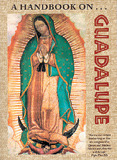 A Handbook on Guadalupe
A Handbook on Guadalupe
Brother Francis Mary, F.F.I., Editor
This is the most authoritative, complete and up-to-date book on all the facts, history and devotion of the story of Our Lady of Guadalupe. It includes the latest research and contributions from numerous Guadalupe experts including Fr. Christopher Rengers, Dr. Charles Wahlig, Janet Barber, Fr. Martinus Cawley and many others. Articles on over 35 topics, both scholarly and popular, include the historical roots of Guadalupe, scientific studies of the tilma, miracles and conversions, and much more. It offers the most in-depth treatment available of the biblical, liturgical, sociological, historical and scientific evidence on the Image and Our Lady's message for today. Includes many color photos.
Regular price: $12.95, sale price: $10.36
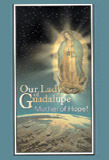 Our Lady of Guadalupe
Our Lady of Guadalupe
A stirring documentary that tells the story in complete detail of the history of the appearance of Our Lady of Guadalupe in Mexico in 1531. It urges us to heed the message of the Pope to promote Our Lady to end abortion and to evangelize America. It tells of miracles and conversions through the presence of Our Lady's image. Experts include Warren Carroll, Dan Lynch, and more.
Regular price: $19.95, sale price: $15.96
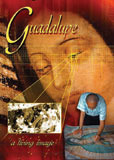 Guadalupe: A Living Image
Guadalupe: A Living Image
When the Virgin Mary appeared to Juan Diego in Mexico in 1531 to give him a message for the Bishop, she left a miraculous image of herself on his tilma. Centuries later, the results of scientific analysis of the image on the tilma are amazing. In the Virgin's eyes the 13 figures who witnessed the miracle are visible. The stars on her cloak are positioned exactly as they were on the day of the miracle in 1531. The painting technique used is unknown. The colors are vibrant and intact; the cloth itself uncorrupted by time. An extraordinary discovery reveals the Spanish origin (from Extremadura, Spain) of the name of Guadalupe and its incredible connection with the Evangelist St. Luke.
Regular price: $24.95, sale price: $19.96
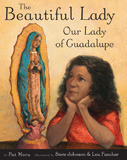 The Beautiful Lady
The Beautiful Lady
Pat Mora
Every December, Grandma Lupita tells Rose the true story of Our Lady of Guadalupe. As they make paper flowers to put around her statue, Grandma begins: Long ago, in the year 1531, on a cold December morning near what is now Mexico City, a man named Juan Diego put on his cloak and started down the road to church . . . On his way, Juan Diego sees a beautiful Lady at the top of a hill. She tells Juan Diego to go to the Bishop and ask him to build a special church for her. There she will hear all the prayers and needs of her children. But the Bishop doesn't believe that Juan Diego has seen the Lady; he asks for a sign. Again the Lady sends Juan Diego, and again the Bishop asks for a sign. Until finally, she provides an amazing, miraculous sign: her beautiful image on Juan Diego's cloak for everyone to see.
The Bishop realized Juan was telling the truth, and built a great Church in her honor. Today in Mexico City the big Shrine still stands in honor of Our Lady of Guadalupe, where millions of pilgrims visit every year to show their love for Our Lady. And the same cloak that Juan Diego wore, on which the beautiful image of Our Lady was printed, still hangs in the Shrine.
Regular price: $16.95, sale price: $13.56
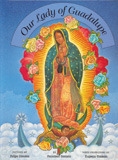 Our Lady of Guadalupe: A Pop-Up Book
Our Lady of Guadalupe: A Pop-Up Book
Francisco Serrano
Our Lady of Guadalupe is the most important religious icon in the Americas. This lavish, colorful pop-up book tells her story and that of Juan Diego, the humble Mexican peasant to whom she appeared on Tepeyac hill in Mexico. The Virgin tells Juan Diego that Tepeyac is where she would like her sacred house built, that she will love and help all who seek her there, and that he must relay this to the Bishop. At first Juan Diego is not believed, and the bishop asks that he return with proof. Vivid pop-ups convey the anticipation when the Virgin tells him to fill his cloak with flowers and the thrill as Juan Diego presents the flowers to the bishop, revealing a beautiful image of the Virgin on his cloak.
Regular price: $22.95, sale price: $18.36
Catholic World ReportThe Pope Emeritus and the Questioning Atheist
By James V. Schall, S.J.
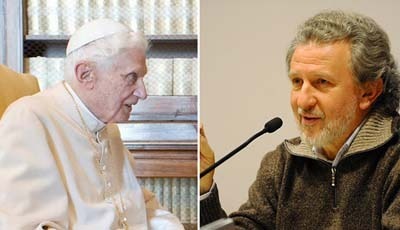
A recently released letter by Benedict XVI confronts and challenges several faulty premises of militant atheism.
“Distinguished Professor, my critique of your book [Dear Pope, I’m Writing to You (2011)], is, in part, tough. However, frankness is a part of dialogue. Only thus can knowledge grow. You have been very frank and so you will accept that I am, too. In any case, however, I consider it very positive that you, in confronting my Introduction to Christianity, have sought such an open dialogue with the faith of the Catholic Church and that, despite its contrasts, at the centre of it all, convergences are not completely lacking.
— Benedict XVI, “Letter to an Atheist” (National Catholic Register, November 26, 2013)
In September, the Italian newspaper, La Repubblica, published a letter of Pope Benedict to Professor Piergiorgio Odifreddi. The whole of this letter was finally published in English in the National Catholic Register on November 27. In 2011, Odifreddi had published a book in the form of an open letter to the Pope about his understanding of the Pope’s position on various basic issues. Obviously ... Homiletic & Pastoral Review Faith in the Year of Faith: The Early Proposal of Joseph Ratzinger
By Father Pablo Sarto
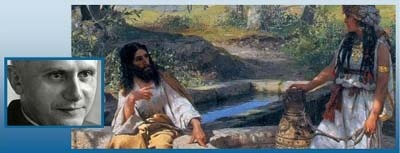
…It is only when we exercise obedience and the expression of our own personality at the same time that we have real faith. Faith is born from the union of the two freedoms: God’s and ours.
In his Introduction to Christianity, written while he was living in a revolutionary Tübingen, Professor Ratzinger examined the problem of faith in contemporary society. He was writing in the famous year of 1968, surrounded by the student riots, and in a context of polemic and skepticism that is almost ancient history today. The three Ms—Mao, Marx, and Marcuse—were put up against Kierkegaard, Heidegger, and Barth, names that were already gathering rust. The question addressed in the book was how to understand faith in that turbulent world. Ratzinger turned to a story once told by Kierkegaard ...
Bring the epic film Mary of Nazareth to a theater near you!
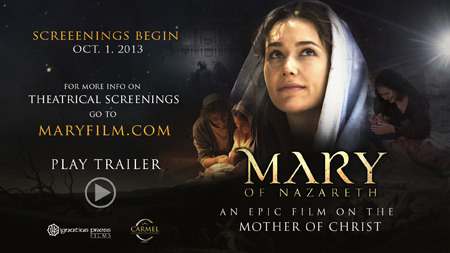
If you are interested in sponsoring a theatrical screening and would like more information, please visit: http://www.maryfilm.com/bring-to-a-theater-near-you, or
email: screenings@carmelcommunications.com,or call (866) 777-2313
And be sure not to miss the theatrical screenings of the new epic film, Mary of Nazareth that are coming to your area. For specific locations, dates, and times, and to purchase tickets please visit: http://www.maryfilm.com/showtimes
Carl E. Olson's Blog
- Carl E. Olson's profile
- 20 followers



